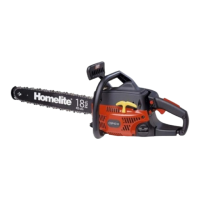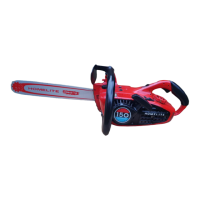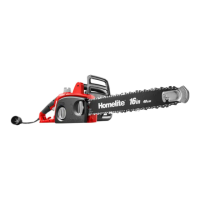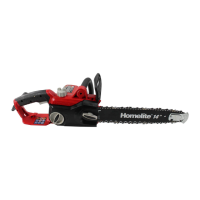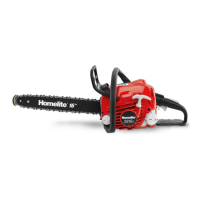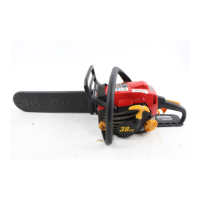CHAIN
TENSION
1.
Proper tension is extremely important. The mounting
nut should be loose enough to permit movement of the
guide bar tension adjustment. Hold up the nose of the
bar during theadjustment
stepsand until the mounting
nut has been tightened completely. This will take up
any clearance between the bar mounting slot and the
mounting pins in the direction in which pressure is
most often applied during cutting.
2. "Snap" the chain to remove any kinks (pull chain away
from bar and let go several times).
Proper cold tension: As tight as possible without
causing binding. Chain tie-straps should remain in
contact with bar along bottom rails.
Adjustment of warm chain: Tighten until tangs move
halfway up into bar groove. Check tension after bar has
cooled, because only a cool chain can be tensioned
accurately.
3. Because steel expands as its temperature rises, you
will be concerned with two conditions.
a) The first is "cold tension". When first mounted on
the bar, the chain is cool and should be "snug" or
taut
-
As much tension as possible without your
feeling any binding as you pull the chain along the
bar by hand. We call thissetting "cold
tension."You
should not seeany clearance between the tie-straps
and the bar rails along the bottom of the bar. Tighten
the mounting nut to lock the assembly at this ten-
sion. Now you are ready to fill the saw with chain
oil and fuel and make some cuts.
b) The second condition
isUwarm tension." As you op-
erate the saw, the chain will heat up and expand,
developing "droop" (too little tension). Operating
with a drooping chain is damaging to the chain, bar
and engine. It is also dangerous to cut with a droop-
ing chain which can catch in the wood and pull or
throw you. When wearing in a new chain and bar,
you should stop to adjust the tension after each four
or five cuts for the first tankful of fuel consumed.
During this period, the droop will be due partly to
warming of the steel and partly to loosening of the
chain joints. After the joints are worn in, the chain
will stretch from heat, but will return to the original
tension when it has cooled.
EXCESSIVE DROOP
4. Any time the chain droops to where the chain tangs
hang out or almost out the bar groove (as illustrated in
the picture labeled "excessive droop") you must shut
off the engine immediately and do the following:
a) Take off your glove and feel the chain. If you cannot
hold chain in your fingers without discomfort while
counting to 20, the chain is too hot to adjust accu-
rately. If you try to adjust an overheated chain, you
will fail because
thechain will becontracting rapidly
as you proceed. Let
thechain cool to where you can
hold it comfortably before making the adjustment.
b) A warm chain should not be adjusted to the same
tension as a cold chain. When chain is warm adjust
to where the clearance between the tie-straps and
bar rails at bottom, center of bar is about
1/8"
(3,2mm) or to half the depth of the tangs (see
"Proper Warm Chain Tension" illustration).
CAREFUL
Upon cooling, the chain may become too tight on the bar.
Before next use, the tension should always be adjusted
for proper "cold tension" after it has cooled.
5.
A chain will get too hot if it is underoiled, improperly
sharpened or dull, or if you are cutting hard, seasoned
wood. Make it a habit to know whether your chain is in
good cutting condition and is getting enough lubri-
cation. An underoiled chain will get so hot that the
joints will stiffen and
thechain will then bind on the bar.
If this occurs let bar and chain cool, then remove them.
Clean all sawdust from
theguide bar mounting pad and
clutch area of the engine. Clean out the oil discharge
hole in the guide bar pad, and all the sawdust from the
guide bar. Reassemble and tension the chain on the
saw. Fill the chain oiler with oil. Start up and run the
engine for
30
seconds at full throttle. Shut off the en-
gine and examine the chain drive
linksand joints.They
should appear moist with oil. If dry, have the saw
checked by your dealer.
CHAIN OIL AND
THE
OIL
SYSTEM
1.
The chain oil and fuel mix tanks are identified in raised
letters on the left side of the saw. The fuel cap is RED.
The chain oil cap is BLACK. Be sure to fill the chain oil
tank with oil every time you fuel the saw, but always be-
low the check valve.
CHAIN OIL
PRESSURE
LINE
AND CHECK VALVE.
DO NOT
FILL TANK
ABOVE VALVE
LEVEL.
NOTE
Constant jiggling in a vehicle, or upside-down storage of
a saw having a full tank of chain oil, can force oil back
through the oil pressure line into the cylinder. This oil may
lock the engine hydraulically, preventing cranking. To
avoid this occurance, be sure to fill the oil tank only to
just below the oil pressure line and check valve. This as-
sembly can be seen in the neck of the oil tank. Whenever
the engine refuses to turn over, remove the spark plug to
break the hydraulic lock. Then crank the engine several
times to dispel the oil. Clean the spark plug thoroughly
before you reinstall it.
Wipe down the saw if any oil or fuel is spilled on it. Keep
the saw handles clean.
2.
Type of oil:
HOMELITEB Bar and Chain Oil
should be used just
as it comes from the container, as it is formulated with
"viscosity improvers" which render it free-flowing
even at below zero temperatures. It has the property
of clinging to the chain to minimize "throw-off".
Any brand of clean motor oil including reprocessed oil
may be used as a substitute chain oil. However, in ex-
tremely cold weather, SAE
30
weight oil should be
diluted in the proportion of
1
part keroseneto4 partsof
oil to restore free-flowing properties. Never use dirty
oil or used oil in the chain oiler system as it may dam-
age the oil pump.

